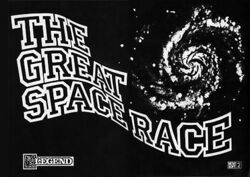The Great Space Race
Topic: Software
 From HandWiki - Reading time: 2 min
From HandWiki - Reading time: 2 min
| The Great Space Race | |
|---|---|
 Cover art | |
| Developer(s) | Legend |
| Publisher(s) | Legend |
| Platform(s) | ZX Spectrum |
| Release |
|
| Genre(s) | Interactive fiction |
| Mode(s) | Single-player |
The Great Space Race is a ZX Spectrum space-based combat and adventure game published in 1984 by British studio Legend.
Gameplay
The Great Space Race is a combination role-playing game and science-fiction space combat game. The basic premise of the game is that a new super-drink called Natof has been discovered. Natof has three key properties, which are to get the person drunk, never leave him with a hangover, and supply him with all the nutrition required from a well-balanced (if never sober) diet.
The name Natof is a portmanteau of the phrase "NAme TO Follow" - the sentence sent with the first batch of miracle drink by the discoverer.
The manual describes the game as "a true computer movie. The player can just watch events unfold, joining in as much or as little as he wishes." The objective is "to deliver, to the space stations as much Natof as the player can, as fast as he can." The game will play itself if left alone — indeed the computer generally makes a better player than a human does — although that rather defeats the point of the game.
Development
The publishing house Legend was also known as Microl/Legend, and earlier as simply Microl. Legend's chairman and founder was John Peel. The developers of The Great Space Race credited in the instruction manual are David Ashe, Graham Asher, Martin Carty, Karl Curtis, Richard Edwards, Trevor Inns, Declan Kirk, James Learmont, Adrian Marler, Bruce Menzie, Peter Moxham, Andrew Owen, Jan Peel, and John Peel. The publisher claimed an investment of £250,000 for the title.[1]
Reception
The Great Space Race was anticipated as the follow-up to Legend's graphic adventure Valhalla. Pre-release publicity boasted that the game contained "technical effects never before seen in home computer software", with "true solid 3D graphics".[2] The game was largely coded in BASIC.[3]
After its release, the game was described by Sinclair User as "one of the most vacuous products we have seen."[4] The graphics also did not impress, as Big K magazine panned "Graphics are great - by 1982 standards. In 1985 they look amateurish and unprofessional".[5] More recent retrospective reviews (c.2010s) confirm The Great Space Race as a poor product that was greatly over-hyped.[6][7]
References
- ↑ Mike Gerrard: Adventuring into an Unknown World. In: The Guardian, 1984-08-30, section Micro Guardian/Futures, page 13.
- ↑ Your Spectrum, issue 08, October 1984
- ↑ Crash, Issue 13, February 1985
- ↑ Sinclair User, March 1985
- ↑ Big K, Issue 12, March 1985
- ↑ "THE GREAT SPACE RACE", www.retrogamer.net, 24 August 2010, http://www.retrogamer.net/retro_games80/the-great-space-race/
- ↑ "Review a Bad Game Day: The Great Space Race", leveluparchive, 7 Aug 2012, https://leveluparchive.wordpress.com/2012/08/07/review-a-bad-game-day-the-great-space-race/
External links
- The Great Space Race at Spectrum Computing
 |
 KSF
KSF